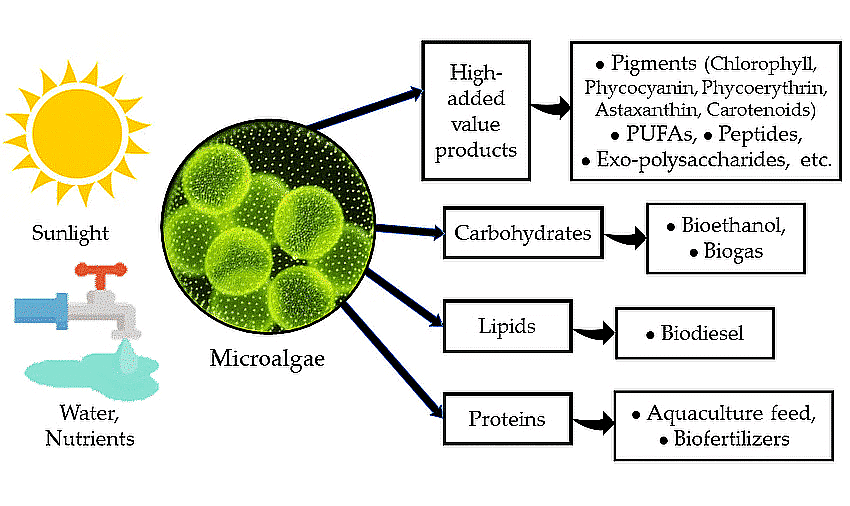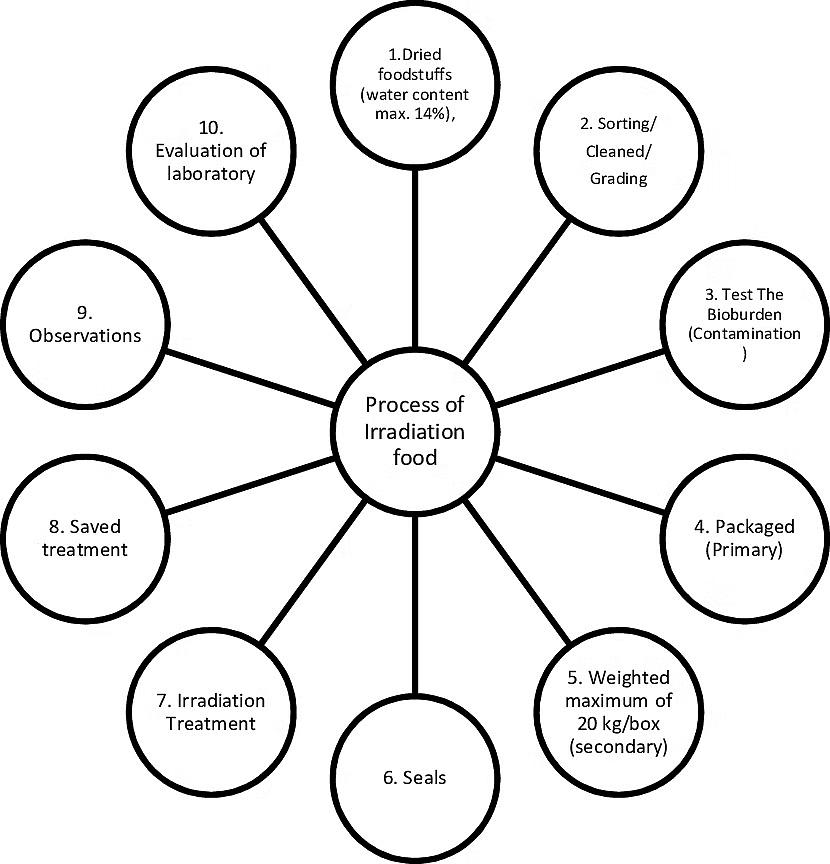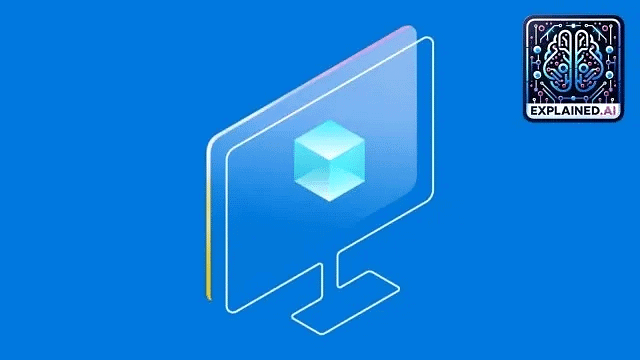Science and Technology: June 2024 Current Affairs | General Test Preparation for CUET UG - CUET Commerce PDF Download
Chlorella Growth Factor
Why in news?
Recently, scientists at CSIR-Indian Institute of Chemical Technology (IICT) have highlighted the potential of Chlorella Growth Factor (CGF), a protein-rich extract derived from the microalgae ‘Chlorella sorokiniana,’ as an ideal ingredient for a wide range of food and feed applications.
What are Chlorella Growth Factor (CGF) and Chlorella Sorokiniana?
Chlorella Growth Factor (CGF):
- CGF is rich in amino acids and proteins of high quality, making it a promising alternative source for both human and animal diets.
- It contains essential amino acids and nutrients like peptides, nucleotides, polysaccharides, vitamins, and minerals, more than commercial soy meal.
- The extraction of CGF involves a non-chemical autolysis process, preserving the integrity of amino acids and other valuable components.
Application:
- Adding CGF to chicken feed improves egg quality, showing promise as a better protein supplement for animals.
Sustainability:
- Microalgae like Chlorella sorokiniana are considered "under-exploited crops" that do not compete with traditional food crops for space and resources, offering a sustainable solution to meet the increasing global demand for high-quality protein sources.
Chlorella Sorokiniana:
- Chlorella Sorokiniana, an oval-shaped single-celled algae, is a standout in the microscopic realm, boasting a unique ability to grow actively.
- Each cell is a self-contained organism with all the essential nutrients needed for life, making it complete and self-sustaining.
- Chlorella Sorokiniana can rapidly reproduce, growing from one cell to 24 cells in just 24 hours when exposed to plenty of sunlight and nutrients.

Multi-drug Resistant Pathogens in ISS
Why in news?
Recently, a collaborative study between scientists from the Indian Institute of Technology Madras (IIT-M) and NASA’s Jet Propulsion Laboratory (JPL) focused on understanding the behaviour of multi-drug resistant pathogens aboard the International Space Station (ISS).
What are the Key Highlights of the Study?
- Enterobacter bugandensis is associated with hospital-acquired infections and poses a significant treatment challenge due to its broad resistance to third-generation antibiotics like cephalosporins and quinolones.
- It is listed by the World Health Organization (WHO) as a priority for developing new antimicrobials.
- The ISS's unique environment of microgravity, heightened carbon dioxide, and increased radiation revealed accelerated mutations that differentiate them genetically and functionally from their Earth counterparts.
Antimicrobial Resistant-Microbes
- Antimicrobial-resistant microbes occur naturally and are found in people, animals, food, and the environment (in water, soil, and air).
- They can spread between people and animals, including from food of animal origin, and from person to person.
- AMR is facilitated by the inappropriate use of medicines, for example, using antibiotics for viral infections such as the flu.
What is an Atomic Clock?
Why in news?
Researchers have built a portable optical atomic clock that can be used onboard ships.
About Atomic Clock:
- An atomic clock is a device that measures time using the vibrations of atoms.
- It uses the oscillations of the electrons in atoms to keep time.
- It is the most accurate time-keeping device available, with a margin of error of just a few billionths of a second per day.
- Atomic clocks are far more precise than conventional clocks because atomic oscillations have a much higher frequency and are much more stable.
- They are used in many applications that require very precise timing, such as systems, telecommunications networks, and scientific research.
How does an atomic clock work?
- Atomic clocks work by using a type of atom called a "cesium atom".
- Cesium atoms are very stable and have a very specific frequency at which their electrons vibrate.
- This frequency is used as the basis for the atomic clock's timekeeping.
- To measure time using cesium atoms, an atomic clock uses a device called a "microwave cavity".
- The microwave cavity is a chamber that is filled with cesium vapor.
- A microwave signal is then sent into the cavity, which causes the cesium atoms to vibrate.
- As the cesium atoms vibrate, they emit radiation at a very specific frequency.
- This frequency is then detected by a detector and compared to a standard frequency.
- The difference between the two frequencies is used to adjust the clock's timekeeping.
Types of atomic clocks:
- There are two types of atomic clocks: cesium atomic clocks and hydrogen maser atomic clocks.
- Cesium atomic clocks are the most common and are used to define the international standard for time, Coordinated Universal Time (UTC).
- Hydrogen maser atomic clocks are even more accurate than cesium atomic clocks and are used in scientific research.

Role of Nuclear Technology in Global Food Safety
Why in news?
Recently, an International Symposium on "Safe Food for a Better Life", jointly organised by the Food and Agriculture Organisation (FAO) and the International Atomic Energy Agency (IAEA) emphasised the importance of nuclear technologies for measuring, managing and controlling food safety. Furthermore, the symposium highlighted the potential use of nuclear technology in ensuring food security.
What is the Application of Nuclear Technology on the Food Safety Standard?
- Complementary to One Health Approach:
- The One Health approach recognises the interconnectedness of human, animal, and environmental health; nuclear techniques can be used to detect and monitor contaminants, pathogens, and toxins in food and the environment.
- Polymerase Chain Reaction (PCR) tests:
- A molecular nuclear technique to rapidly detect animal diseases in less than a day.
- Food Irradiation:
- A process of exposing food to ionising radiation to eliminate harmful bacteria, pathogens, and pests; nuclear technology helps to extend the shelf life of food products and ensure their safety for consumption.
- Stable isotope analysis:
- A nuclear technique used to determine the origin and authenticity of food products, helping to detect adulteration and verify labelling claims.
- Improved Soil and Water Management:
- Past nuclear fallouts help scientists measure and assess soil erosion, aiding in determining the health of soils and rate of erosion.
- Pest Control:
- Nuclear techniques such as the Sterile Insect Technique (SIT) are used for pest control in agricultural production systems, limiting reproduction and suppressing insects and pests, thereby reducing the need for chemical pesticides.
- Plant Breeding and Genetics:
- Nuclear technology applied in crop breeding facilitates the development of enhanced varieties capable of adapting to climate change by subjecting seeds to irradiation, initiating genetic alterations and expanding genetic diversity available for breeding purposes.

What is the Need for Tech-Related Advancements in Food Security?
- Climate Change:
- Climate-induced challenges such as droughts, floods, and temperature fluctuations can adversely affect crop production and food availability, necessitating the promotion of climate-smart agriculture (CSA).
- Food Waste:
- Roughly 1/3rd of food produced for human consumption is lost or wasted globally, amounting to about 1.3 billion tons annually; approximately 3.1 billion people could not afford a healthy diet in 2020.
- Increasing Population:
- The world's population is projected to reach 9.7 billion by 2050, placing immense pressure on food production systems, thereby requiring technological advancements.
- Limited Resources:
- With limited arable land and freshwater resources, technology can help maximise productivity through vertical farming, hydroponics, and efficient irrigation systems.
What Challenges are Associated with using Nuclear Technology for Food Safety?
- Geographical and Regional Variations:
- Diverse agro-climatic regions and farming practices can pose challenges in the uniform application and adaptation of nuclear techniques globally, requiring region-specific calibration and adaptation.
- Limited Funding and Investment and Technology:
- The development of irradiation facilities for food preservation and pest control necessitates significant capital investment, which may be challenging due to budget constraints.
- Accessing advanced techniques like accelerator-based mutation breeding or specialised analytical equipment for food traceability may be difficult due to technology transfer restrictions or high costs.
- Regulatory Challenges:
- The use of nuclear technology in agriculture is subject to strict regulations and guidelines to ensure safety and security, making the process of obtaining necessary approvals, licences, and compliance complex.
- Various factors, including intellectual property rights and technology transfer barriers, hinder adaptation.
- Lack of Allied Infrastructure:
- Lack of specialised laboratories and research facilities, along with a shortage of trained personnel and expertise, limits the widespread application of nuclear techniques in agriculture.
Way Forward
- Developing Infrastructure and Facilities:
- Allocate funds and resources to set up irradiation facilities, analytical labs, and equipment for nuclear technology, such as a food irradiation facility to preserve perishable produce, reduce losses, and ensure food safety.
- Regulatory Reforms and Streamlining Processes:
- Create guidelines for the safe handling, transport, and disposal of radioactive agricultural materials and form a regulatory body to oversee the approval and commercialisation of radiation-induced mutant crops.
- Promoting Public-Private Partnerships:
- Promote collaborations between research institutions, the private sector, and the industry for nuclear technology transfer, and offer incentives for companies to invest in developing and commercialising nuclear-based agricultural products.
- International Cooperation and Knowledge Sharing:
- Foster international collaborations, such as partnering with the Joint FAO/IAEA Centre for expertise and technology transfer.
Dimensions of Colours
Why in News?
Colour profoundly shapes contemporary human life by enriching the aesthetic and symbolic aspects of our surroundings, embracing cultural diversity in its interpretation, and deepening our comprehension of the world and our role within it.
What are Colours?
About:
- Colour is the result of processing electromagnetic radiation by the human visual system.
- Cone cells in the human eye detect and transmit information about light wavelengths to the brain, allowing for the perception of colour.
- Humans possess three types of cone cells, enabling trichromatic vision, while some animals, like birds and reptiles, have four cone types (tetrachromats).
- Human vision is limited to wavelengths ranging from 400 nm to 700 nm (visible light); honeybees can also 'see' ultraviolet light, and mosquitoes and some beetles can access information in wavelengths of infrared radiation (Humans sense it as heat).
Science of Colours:
- Traditional colour theory emphasizes combining 3 primary fixed colours (red, green, and blue) to make other colours.
- Modern colour theory argues that all colours can be produced by combining any three colours in different ways.
Two Ways of Rendering Colours:
- Additive Colouring: Mixing light wavelengths to produce different colours, as seen in electronic displays like smartphone screens and TVs, utilizing the RGB colour space.
- Subtractive Colouring: Achieving colours by subtracting specific wavelengths from white light, commonly done with dyes, pigments, and inks.
Properties of Colour:
- Hue: Degree of similarity or difference to standard colours like red, orange, yellow, etc., influencing the perceived colour.
- Brightness: Related to an object's luminance, reflecting the amount of light emitted or reflected.
- Lightness: Perception of an object's brightness compared to a well-lit white object.
- Chromaticity: Perception of colour quality irrespective of lighting conditions.
Significance of Colour:
- Colour significantly impacts how humans perceive and interact with the world around them.
- Colour influences various aspects of human culture, including art, social hierarchy, philosophy, trade, innovation, symbolism, politics, religion, and responses to phenomena like climate change.
- Both natural phenomena and human-made objects like paintings gain aesthetic appeal and convey symbolic significance through colour.
- Certain colours convey universal messages (e.g., red as a stop sign).
Examples of Colour's Impact:
- Archaeological evidence suggests early human societies used ochre pigment for cultural practices, indicating their intelligence and artistic expression.
- Blue LEDs revolutionized industries by completing the RGB colour space, enabling energy-efficient lighting solutions and advancements in consumer electronics.
Food Irradiation
Why in News?
The government of India plans to utilize radiation processing (Food Irradiation) to enhance the shelf life of a 100,000 tonne onion buffer stock this year, with the aim of averting shortages and price surges. India, a significant onion exporter, is confronting a 16% reduction in onion output for the 2023-24 season, which has brought production down to an estimated 25.47 million tonnes.
What is Food Irradiation?
About:
- Food irradiation involves exposing food and food products to ionizing radiation, such as gamma rays, electron beams, or X-rays. It is employed in food processing to ensure food safety.
Need:
- Seasonal overstocking and extended transport durations result in food wastage. India's hot and humid climate serves as a breeding ground for spoilage-causing insects and microbes. Post-harvest losses in India account for approximately 40-50% in food and food grains, primarily due to insect infestation, microbiological contamination, sprouting, ripening, and poor shelf life.
- Seafood, meat, and poultry can harbor harmful bacteria and parasites that can cause illnesses.
Applications:
- Food irradiation aids in preventing spoilage, eliminating germs, controlling pests (by eradicating insects in stored food), delaying sprouting, and more.
Phi-3-mini
Why in news?
Phi-3-mini is the latest lightweight AI model introduced by Microsoft. It has surpassed models of similar and larger sizes in various benchmarks such as language, reasoning, coding, and mathematics. This model supports a context window of up to 128K tokens, setting a new standard in the field. With a capacity of 3.8 billion tokens, Phi-3-mini is available on platforms like Microsoft Azure AI Studio, Hugging Face, and Ollama. It is offered in two versions: one with 4K content-length and another with 128K tokens.
About Phi-3-mini
- Phi-3-mini is the newest addition to Microsoft's AI model lineup.
- It excels in language, reasoning, coding, and mathematics tasks.
- Supports a context window of up to 128K tokens with minimal quality impact.
- Available on AI development platforms like Microsoft Azure AI Studio, Hugging Face, and Ollama.
Distinguishing Features from Large Language Models
Small Language Model (SLM):
- SLMs are streamlined versions of large language models that are cost-effective and perform well on devices like laptops and smartphones.
- They are ideal for resource-constrained environments and scenarios requiring fast response times.
- SLMs can be customized for specific tasks, offering accuracy and efficiency with reduced computing power requirements.

AstraZeneca's Covishield and Thrombocytopenia Syndrome (TTS)
Why in news?
AstraZeneca, the company behind the Covishield vaccine, has acknowledged rare side effects associated with the vaccine, including Thrombosis with Thrombocytopenia Syndrome (TTS).
What is Covishield?
- Covishield is the brand name for the vaccine developed by AstraZeneca for the Covid-19 pandemic.
What is Thrombosis with Thrombocytopenia Syndrome (TTS)?
- TTS is an uncommon condition characterized by blood clot formation and low blood platelet levels.
What exactly has AstraZeneca said?
- AstraZeneca has disclosed that in rare cases, Covishield can lead to TTS, as mentioned in a legal document submitted to the High Court of Justice in London.
About Covishield in India
- In India, Covishield is the AstraZeneca vaccine manufactured by the Serum Institute of India (SII) and advised with caution for individuals with low platelet counts.
- The Union Health Ministry emphasized the vaccine's positive benefit-risk profile despite rare side effects.
AstraZeneca vaccine in other countries
- In 2021, several European nations paused AstraZeneca vaccinations due to reported cases of blood clotting.
Observations made by WHO
- The World Health Organization noted cases of TTS post-Covishield vaccination but emphasized a low risk associated with the vaccine.
Mechanism of TTS
- The precise mechanism of TTS post-Covishield vaccination is not fully understood but is hypothesized to involve immune responses triggering blood clot formation.
Symptoms of TTS
- Symptoms of TTS include breathlessness, chest or limb pain, skin bruising, headaches, and potential severe complications like stroke or heart attack.
Who are at risk?
- Factors such as age, gender (more common in young women), and genetic predispositions may contribute to TTS risk.
AstraZeneca's response to legal action
- AstraZeneca denied a generic link between the vaccine and TTS but acknowledged the rare possibility of TTS post-vaccination.

Eta Aquariid meteor shower
Why in news?
The Eta Aquariid meteor shower, which has been active since April 15, will peak on May 5 and 6. Comprising burning space debris moving at speeds of around 66 km per second (2.37 lakh kmph) into Earth’s atmosphere, these showers are seen in May every year. They are best visible to countries such as Indonesia and Australia in the Southern Hemisphere.

Why in News?
The Eta Aquariid meteor shower, which has been active since April 15, will peak on May 5 and 6.
Comprising burning space debris moving at speeds of around 66 km per second (2.37 lakh kmph) into Earth’s atmosphere, these showers are seen in May every year. These are best visible to countries such as Indonesia and Australia in the Southern Hemisphere.
What are comets?
- About
- Comets are icy, small, cosmic snowballs of dust, rock, and frozen gases that orbit the Sun.
- They are often called dirty snowballs and are thought to be remnants from the formation of the solar system about 4.6 billion years ago.
- Composition
- Comets are made up of a nucleus, coma, hydrogen envelope, and dust and plasma tails.
- The nucleus is a loose collection of ice, dust, and small rocky particles that can range from a few hundred meters to tens of kilometers across.
- Location
- They are located in two regions of the solar system:
(i) Kuiper Belt
(ii) Oort Cloud
- They are located in two regions of the solar system:
- Features
- Comets orbit around the Sun in highly elliptical orbits which can, in some cases, take hundreds of thousands of years to complete.
- Comets come in different sizes, although most are roughly 10 km wide.
- However, as they come closer to the Sun, comets heat up and spew gases and dust into a glowing head that can be larger than a planet.
- This material also forms a tail which stretches millions of miles.
- Meteors
- Meteors are simply grains of dust or rock that burn up as they enter the Earth’s atmosphere. This burning also creates a brief tail.
- Since most meteors are tiny (the size of a grain of sand) they completely burn up in Earth’s atmosphere.
- However, once in a while, a large enough meteor passes through and hits the ground (at which time it is called a meteorite), often causing significant damage.
- Meteor Showers
- A meteor shower can be observed when Earth passes through the clouds of dust left behind in a comet’s orbital plane.
- The sky lights up with small and large meteor tails as the debris left behind by the comet interacts with Earth’s atmosphere.
- The Eta Aquariid meteor shower is formed when Earth passes through the orbital plane of the Halley’s Comet, which takes about 76 years to orbit the Sun once.
- The shower seems to be originating from the Aquarius constellation — hence ‘Eta Aquariid’.
- Uniqueness
- The Eta Aquariid meteor shower is known for its rapid speed. This makes for long, glowing tails which can last up to several minutes.
- According to NASA, about 30 to 40 Eta Aquariid meteors can be seen per hour during the peak of the meteor shower, if observed from the Southern Hemisphere.
- The number decreases to about 10 meteors per hour if being viewed in the Northern Hemisphere.
- This is due to the location of the “radiant” — the position in the sky where the meteor shower seems to come from.
Chloropicrin
Why in news?
The U.S. State Department accused Russia of using the chemical agent chloropicrin in Ukraine, violating the Chemical Weapons Convention.
About Chloropicrin:
- Chloropicrin, also known as nitro chloroform, serves both as a warfare agent and pesticide.
- Appearance: It presents as a colorless to yellow oily liquid.
- Usage: It functions as a fungicide, herbicide, insecticide, nematicide, and antimicrobial.
- Characteristics: It acts as an irritant akin to tear gas, with a pungent odor and multiple absorption pathways including inhalation, ingestion, and skin contact.
- Historical Context: Initially developed as a poison gas during World War I, employed by both the Allied and Central Powers.
Manufacturing
- Chloropicrin is produced through a chemical reaction involving sodium hypochlorite (bleach in dilute form) and nitromethane (an industrial solvent).
- An alternative method involves combining chloroform with nitric acid to yield chloropicrin and water.
Impacts on Health
- Chloropicrin exhibits documented irritant and tear-inducing effects on humans, alongside high toxicity, carcinogenicity, and the induction of vomiting.
Key facts about Chemical Weapons Convention
- A multilateral treaty prohibiting chemical weapons and mandating their destruction within a specified timeframe.
- Effective since April 29, 1997, it necessitates states to disclose their chemical weapons stockpiles, production facilities, and related information to the OPCW.
- Open to all nations, with 193 current states-parties, including India, a signatory since January 14, 1993.
- India has enacted the Chemical Weapons Convention Act, 2000, in alignment with treaty provisions.
What is Thalassaemia?
Why in news?
World Thalassaemia Day is celebrated on May 8, every year.
About Thalassaemia

Overview:
- Thalassaemia is the name for a group of inherited conditions affecting haemoglobin in the blood.
- People with thalassaemia produce insufficient haemoglobin, crucial for carrying oxygen in red blood cells.
- Mainly affecting individuals of Mediterranean, south Asian, southeast Asian, and Middle Eastern descent.
Cause:
- Thalassaemia is caused by faulty genes impacting haemoglobin production.
- A child inherits thalassaemia only if both parents carry these faulty genes.
- Some individuals may be carriers of thalassaemia, known as having the thalassaemia trait.
Symptoms:
- Anaemia leads to severe fatigue, weakness, shortness of breath, palpitations, and pale skin due to low haemoglobin levels.
- Excess iron accumulation from blood transfusions can result in heart, liver, and hormonal issues if untreated.
- Additional symptoms may include delayed growth, weak bones, and reduced fertility.
Treatments:
- Blood transfusions are essential to treat and prevent anaemia, sometimes necessitating monthly sessions.
- Chelation therapy helps eliminate excess iron build-up from frequent blood transfusions.
- A stem cell or bone marrow transplant offers a potential cure for thalassaemia, albeit with risks.
Global Report on Neglected Tropical Diseases 2024
Why in News?
Ahead of the World Health Assembly 77th session, the World Health Organization (WHO) released its Global report on neglected tropical diseases (NTD) of 2024. The report provides an account of the progress made in 2023 towards the implementation of the Road map for neglected tropical diseases 2021-2030.
Key Highlights of the WHO Report
Global:
- As of December 2023, a total of 50 countries have successfully eliminated at least one NTD, marking the halfway point towards the 2030 target of 100 countries.
- 5 countries were acknowledged for eliminating, and 1 country for eliminating two NTDs.
- In July 2023, Iraq became the 50th to eliminate at least one NTD. This event marks the halfway point towards achieving the 100-country target set for 2030.
- Noma was added to the list of NTDs in 2023.
- In October 2023, Bangladesh became the first country to be validated by WHO for eliminating visceral leishmaniasis as a public health problem.
Status for 2022:
- In 2022, 1.62 billion people required interventions against neglected tropical diseases (NTDs), reflecting a 26% decrease from 2010.
- Approximately 848 million people received treatment for at least one NTD through preventive chemotherapy interventions.
- As of the end of 2022, the number of reported deaths from vector-borne NTDs has increased by 22%.
India:
- India was certified free of NTDs like dracunculiasis and yaws.
- India treated about 117 million fewer people for lymphatic filariasis and soil-transmitted helminthiasis in 2022 compared to 2021.
- 40.56% of India's population needed interventions against NTDs in 2022.
Key Facts About Neglected Tropical Diseases (NTDs)
- NTDs are a diverse group of conditions caused by a variety of pathogens.
- NTDs are mainly prevalent among impoverished communities in tropical areas.
- Epidemiology of NTDs is complex and often related to environmental conditions.
- Compared to diseases like HIV/AIDS, malaria, and tuberculosis, NTDs receive significantly less funding for research and development of treatments.
Global and Indian Initiatives to tackle NTDs
Global Initiatives:
- WHO's 2021-2030 Roadmap prioritises impact over simply treating NTDs.
- 2012 London Declaration recognises the global burden of NTDs.
Indian Initiatives:
- India has successfully eliminated guinea worm, trachoma, and yaws.
- The Accelerated Plan for Elimination of Lymphatic Filariasis (APELF) aims to achieve the same by 2027.
- India partners with WHO in regional alliances.
Conclusion
The 2024 WHO report shows progress in the fight against neglected tropical diseases. Several countries eliminated these diseases in 2023, but more needs to be done to reach global targets. Challenges like funding gaps and the lingering effects of COVID-19 threaten progress. Increased national and global collaboration is necessary for achieving a future free from neglected tropical diseases.
NISAR Satellite will Monitor Tectonic Movements
Why in news?
Recently, ISRO has confirmed that the NISAR Satellite will possess the capability to monitor Earth's tectonic movements with exceptional precision, achieving accuracy down to the centimeter.
About NISAR Satellite
Dual-Band Radar Mission:
- NISAR is the first satellite mission that will collect radar data in two microwave bandwidth ranges:
- L-band (1-2 GHz, commonly used for satellite communication and remote sensing) - L-band payload is made by the U.S.
- S-band (2-4 GHz, commonly used for satellite communication and weather monitoring) - S-band payload has been made by ISRO.
Radar Technology for Earth Imaging:
- 'SAR' (Synthetic Aperture Radar satellite) is a type of remote-sensing technology that uses radars instead of optical sensors to create high-resolution images of the earth's surface. It can penetrate clouds and vegetation to generate accurate data.
Antenna Technology:
- It has a large deployable antenna with an 18-meter diameter, providing a very high swath.
Significance of NISAR Satellite
Comprehensive Earth Monitoring:
- It can fully cover the earth in approximately 14 to 15 days, using radar to monitor various aspects in very high resolution.
- For example, it can monitor tectonic movements with centimeter accuracy and accurately measure water bodies.
Water Stress and Ground Penetration:
- It can observe water stress on the earth where there is a deficiency of water and can penetrate the ground to a certain depth.
Monitoring Vegetation and Snow Cover:
- It is capable of monitoring vegetation cover and snow cover, providing a comprehensive view of the earth's surface, water, greenery, and more.
Changes in Permafrost:
- NISAR is designed to observe global changes in permafrost at regular intervals, updating scientists about its degradation and the implications for global water resources, aquatic ecosystems, coastal water levels, etc.
Monitoring Forests:
- NISAR will monitor global forest resources, including their extent and quality, providing information for their sustainable development and management.
|
164 videos|800 docs|1160 tests
|




















